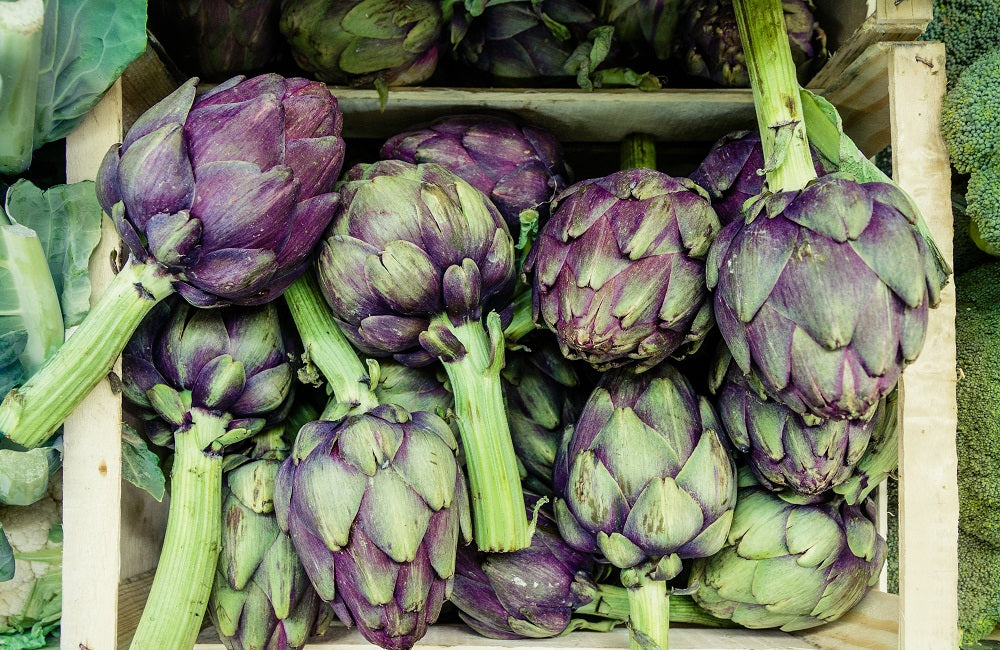Very often, the best remedies are found in nature 🌿
Or by listening carefully to her needs (or even better, by following Grandma's advice 👵).
Diets are good, a healthy lifestyle is better!
Spring is the perfect time to clean up a bit and transition to a lighter diet.
If you're having trouble transitioning from one season to the next, our little Ayurvedic spring routine will definitely help!
After having accumulated toxins and waste throughout the winter with a diet that is sometimes a bit too fatty and sugary, it is time to cleanse the liver and kidneys, by simply incorporating more fruits and vegetables into your menus.
To get the most out of your little detox treatment, set aside saturated fats, alcohol, tobacco, refined sugars, caffeine and preservatives as much as possible.
What if, instead of focusing on losing possible extra pounds, you tried these foods with super detoxifying powers to give your liver and kidneys a little respite?
Best consumed when they are in season and when they are grown nearby!
The lemon
The super star of detox foods, lemon stimulates the activity of the kidneys and thus promotes the elimination of toxins.
How to consume it? In an infusion, in a vinaigrette, as a seasoning for your vegetables.
The cabbage
The whole cabbage family (red cabbage, white cabbage, Chinese cabbage, broccoli, Brussels sprouts, kale, etc.) is very low in calories and will provide you with antioxidants.
Their strong taste is due to sulfur components which help the digestive system after excesses. Rich in vitamin C and E, cabbages contain powerful antioxidants to neutralize excess free radicals.
The cabbage’s favorite? Red cabbage, known to be one of the richest in micronutrients.
How to consume it? Raw or steamed al dente or stir-fried in a wok. Avoid cooking in water so as not to lose a bit of the nutritional properties.
The leek
Still somewhat present on the shelves of vegetable sections at the end of winter, leek is a diuretic and detox vegetable. Rich in fiber, it helps with intestinal transit.
How to consume it? In soup, in fondue, in steamed leek whites. Try not to over-plane the dark green part of the leek which is richest in antioxidant carotenoids and vitamin C.
Apple
Famous proverb, “An apple a day keeps the doctor away forever”.
Is it still necessary to detail the benefits of apples?
To eat it with the skin, consider buying it organic, the apple being one of the fruits most polluted by pesticides!
How to consume it? Dig into it with your full teeth!
Garlic
For yoginis who deviate a little from Ayurvedic recommendations, garlic is a powerful natural antibiotic and antiseptic, which helps the liver in the detoxification process.
How to consume it? Cooked in olive oil as a base for all kinds of curries, in vinaigrettes, in vegetable gratin, in ratatouille...
Turmeric
Very good for the liver, anti-inflammatory and antioxidant, turmeric and its beautiful orange hue colors dishes in the blink of an eye.
How to consume it? As a seasoning in all your dishes, whether vegetables, pasta, rice, etc.
Grapefruit
Grapefruit is an excellent source of vitamins A, C and B5. Packed with antioxidants, it helps the liver burn fat, rather than store it.
How to consume it? For dessert, avoiding adding sugar or pressed into juice!
Green tea
Green tea is considered the beverage with the highest antioxidant activity. Rich in antioxidants (catechins, theaflavins but also thearubigins), tea helps the skin age properly. It would reduce the risk of cardiovascular diseases and help regulate blood sugar levels. It is also an excellent drainer and natural fat burner.
How to consume it? In infusion, avoiding adding sugar.
Vegetable broth
Drink for “free” days, vegetable broth is ideal for recovering from overeating or gastric disorders. On a daily basis, vegetable broth provides the body with a boost of minerals with alkalizing properties, that is to say, which neutralize excess acidity which is harmful to the body. It’s a diuretic drink par excellence!
How to consume it? Homemade preferably, avoid adding too much salt.
Plant infusions
A whole host of infusions are within reach! Nettles, fennel, chamomile, hibiscus, cherry tail, meadowsweet... They help the body with renal elimination. However, be careful not to overconsume it so as not to tire the kidneys.
How to consume them? hot but not hot, ideally without added sugar.
The artichoke
We like it or we don't like it, but artichoke is undeniably the star vegetable of detox. It helps the liver to recover when its detoxification capabilities are put to the test, contributes to the development of bacteria beneficial to the balance of intestinal flora and increases the production of bile to facilitate digestion. Artichoke is an effective diuretic that stimulates the elimination of toxins.
How to consume it? Steamed as a salad with a light vinaigrette sauce.
The radish
Whatever its pink, white or black color, radishes are the crunchy spring vegetable that it would be a shame to deprive yourself of! Very low in calories, it is nevertheless rich in protein and fiber. Radishes help transit and have a satiating effect.
How to consume it? Raw, as a snack or in salad.
Asparagus
A delicate and short-lived dish, asparagus is renowned for its strong diuretic power. Take advantage of them while they are in season! Asparagus is an excellent source of vitamins B9 and K, which are particularly essential for pregnant or breastfeeding women. Rich in dietary fiber, they promote drainage and renal elimination.
How to consume them? Steamed or boiled, they can be eaten with your fingers with a delicious shallot vinaigrette. Avoid cooking them for too long as this risks losing their nutritional properties.
Dandelion
Also called lion's tooth, dandelion has been used for thousands of years to treat digestive disorders. Dandelion stimulates and soothes the liver, acts in cases of constipation or difficult digestion, and prevents kidney problems. Rich in potassium, calcium, magnesium, low in sodium, it stimulates the work of renal elimination and neutralizes excess acidity in the body.
How to consume it? Use the leaves and roots as an infusion
Raspberry
The fruit that combines business with pleasure! Rich in vitamin C, raspberries are also one of the fruits best supplied with iron, essential for red blood cells.
If we continue the comparison, raspberries are also 4 times richer in fiber than other fruits, which helps activate intestinal transit. Raspberries also contain many vitamins and minerals such as potassium, calcium, magnesium, vitamin C and E. It helps to alkalize the body.
If you are tired of eating raspberries, you can alternate with strawberries 😉
How to consume them? Fresh straight after picking.
The almond
A handful of almonds per day would be a real boost for the body. The Egyptians already used them a long time ago and Ayurveda attributes many virtues to them. Almonds are rich in fiber, promoting intestinal transit. Rich in vitamin E, one of the three anti-oxidant vitamins, around twenty almonds provide approximately 70% of an adult's daily needs for this vitamin. Almonds also contain magnesium, calcium, potassium and phytosterols.
How to consume them? Choose plain or dry-roasted almonds, to eat like that by hand without fuss.
Ginger
A root from elsewhere, ginger is widely used in Asian and Ayurvedic cuisine. Known to stimulate the immune system, ginger also promotes digestion and is a powerful anti-inflammatory. Among the spices with the best antioxidant potential thanks to its gingerols, ginger stimulates digestion.
How to consume it? Choose fresh ginger root, rather than powder. Incorporate chopped fresh ginger and sautéed in olive oil into your vegetarian curries.
The Basilic
Strongly fragrant, basil leaves are reminiscent of Italian but also Thai cuisine. Basil is rich in antioxidants, vitamin K, potassium, calcium but also phosphorus and magnesium. Renowned as an antioxidant, it is also a significant source of iron. Like all fresh herbs, it is full of vitamin C.
How to consume it? Fresh in salad.
Beet
With its superb staining red color, beetroot is full of unsuspected virtues. A vitamin concentrate, beetroot also has depurative properties due to its betacyanin content which helps eliminate toxins as well as methionine which helps the body to process body waste, and betanin which helps the liver to metabolize fatty acids.
How to consume it? Raw or cooked in salad, with a drizzle of lemon juice.
Watercress
Watercress belongs to the cruciferous family. Its chlorophyll boosts the production of red blood cells and detoxifying enzymes. Source of carotene, vitamins A, K and C? of minerals, it is as depurative as it is remineralizing!
How to consume it? in soup or salad, combined with other vegetables such as leek and potatoes.
Nettles
Yes, nettles can be eaten 😉
Strongly diuretic, nettles stimulate the kidneys and therefore indirectly eliminate toxins. They activate the secretion of bile by the liver.
How to consume them? In soup with potatoes.
Take care of your health, every day. This allows you to live more peacefully.
In addition to a healthy diet, you could also practice yoga daily, adopt walking meditation or chase away the false ideas that prevent you from moving forward.
What are your favorite detox foods? Tell us in the comments !
Sources:


























Leave a comment